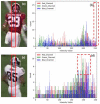Automated player identification and indexing using two-stage deep learning network
- PMID: 37339988
- PMCID: PMC10282031
- DOI: 10.1038/s41598-023-36657-5
Automated player identification and indexing using two-stage deep learning network
Abstract
American football games attract significant worldwide attention every year. Identifying players from videos in each play is also essential for the indexing of player participation. Processing football game video presents great challenges such as crowded settings, distorted objects, and imbalanced data for identifying players, especially jersey numbers. In this work, we propose a deep learning-based player tracking system to automatically track players and index their participation per play in American football games. It is a two-stage network design to highlight areas of interest and identify jersey number information with high accuracy. First, we utilize an object detection network, a detection transformer, to tackle the player detection problem in a crowded context. Second, we identify players using jersey number recognition with a secondary convolutional neural network, then synchronize it with a game clock subsystem. Finally, the system outputs a complete log in a database for play indexing. We demonstrate the effectiveness and reliability of player tracking system by analyzing the qualitative and quantitative results on football videos. The proposed system shows great potential for implementation in and analysis of football broadcast video.
© 2023. The Author(s).
Conflict of interest statement
The authors declare no competing interests.
Figures









References
-
- Sports Media Watch. Super bowl ratings history (1967-present) (2022).
-
- National Football League. NFL Guide for Statisticians (2022). https://www.nflgsis.com/gsis/documentation/stadiumguides/guide_for_stati... (2022).
-
- National Collegiate Athletic Association. The Official National Collegiate Athletic Association 2022 Football Statisticians’ Manual Including Special Interpretations and Approved Rulings Covering Unusual Situations (2022). http://fs.ncaa.org/Docs/stats/Stats_Manuals/Football/2022.pdf (2022).
-
- Nady, A. & Hemayed, E. E. Player identification in different sports. In VISIGRAPP (5: VISAPP), 653–660 (2021).
-
- Šari, M., Dujmi, H., Papi, V. & Roži, N. Player number localization and recognition in soccer video using HSV color space and internal contours. In The International Conference on Signal and Image Processing (ICSIP 2008) (Citeseer, 2008).
Grants and funding
LinkOut - more resources
Full Text Sources

